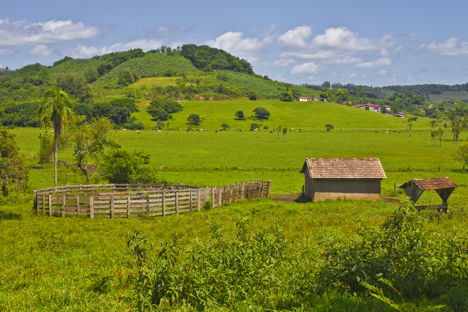
Grills and gauchos: visiting Rio Grande do Sul
Marcello Tully recalls a childhood visit to Brazil's most southern state, Rio Grande do Sul, where churrasco barbecues and caipirinhas are consumed in abundance.
View more from this series:
Brazil's regional cuisineI was around five years old when my parents took me and my two older brothers on a mammoth trip to Rio Grande do Sul (Great Southern River). Departing from Maceió, our home in the north east, this was an incredibly long journey, taking forty-four hours in a rather hot and stifling old car to drive 2,209 miles. To break up the trip, we stayed with relatives along the way and it was a relief when we finally arrived in the coolest region of Brazil.
Rio Grande do Sul is as far south as you can go in the country and summer temperatures range from 22°C in the highlands to 30°C closer to the ocean. Winter temperatures vary from 16°C to 5°C but often reach zero on the coldest days – meaning the region has frequent frosts.
Rio Grande do Sul is bordered by the Brazilian state of Santa Catarina in the north, the Atlantic Ocean to the east, Uruguay to the south and Argentina in the west. The largest city, and its capital, is Porto Alegre.
Southern hospitality
This region of Brazil is known for its Gaucho culture. The Gauchos (cowboys) originated from Europe and arrived in Brazil in the fifteenth century to discover a lush, fertile land. These sprawling landscapes, then unoccupied, were the perfect place for farming. They focused on caring for livestock, capitalising on their experience and maximising the abundance of this new land.
Gauchos are both a national and international curiosity to tourists, and thankfully their customs are kept alive. They have a culture all their own, central to which is the cuisine. The love they have for their land is evident in their common and humorous saying, ‘When God created the earth in six days, he spent five days on Rio Grande do Sul!’
For centuries the staple food of the Gaucho has been meat, cooked Churrasco-style (barbecued). Meat, skewered on metal spits and with a simple seasoning of rock salt rubbed in, was originally cooked over coals, usually in a pit dug in the ground, with the excess salt was then shaken off before eating. Churrasco cooking then spread to Rio de Janeiro and Sao Paulo, but nowadays is prevalent all over Brazil.
Many houses in the region have their own Churrasco pit in their back gardens or incorporated into an outside wall with decorative tiles around the edges. They’re used for any occasion, but mostly celebrations, political rallies, and get-togethers. Across Brazil, lunch is the main meal of the day, with lighter dishes being served later on in the evening.
To my brothers and I, these cowboys were unreal and exciting – dressed in pantaloons, flat caps with chin straps, ponchos draped over their shoulders, neckerchiefs and boots. They were like nothing we had ever seen before, apart from in cowboy films.
There were further surprises in store at the Churrasco restaurants where we ate on huge outdoor patios filled with lively guests. Here the waiters dressed as Gauchos, moving around the tables with large silver spits overflowing with a variety of barbecued meats, again seasoned with rock salt and carved straight from the pit.
A typical Churrasco meal begins with a glass of caipirinha (Brazil's national cocktail, made with cachaça, sugar and lime) served with a nugget of grilled sausage (linguica) on a cocktail stick. Each patron of the restaurant was given a coaster to use as a traffic light-style signal; the green side was shown when you wanted more meat carved for you and the red side when a breather was required, or to signal you were replete!
For three boys with eyes bigger than their bellies it was impossible to decline the chance to try so many different varieties of meat – the huge list included varieties of linguica (sausage), different cuts of beef; sirloin, rump, T-bone and fillet, pork chops, tenderloin and finally chicken thighs, drumsticks and even chicken hearts, all neatly lined up on a skewer. To accompany all this meat there was (thankfully) always a very extensive salad bar, with tasty delights like palm hearts, marinated grilled vegetables, couscous, kale and roasted beetroot, to name just a few.
Marcello Tully
On the side
There was also a selection of sauces and dressings, such as a Molho a Campagna vinaigrette with diced tomatoes, peppers, onions and toasted manioc flour (farinha), which is sprinkled onto so many dishes in Brazil and delicious once you become accustomed to them.
More often than not, the buffet also includes beef stroganoff (a hugely popular dish in Brazil) and the traditional feijao and feijoada (both national dishes with pinto beans, the latter with the inclusion of pork offal).
With no real room for dessert but still with the desire to try, we chose our favourite things from the buffet table: pudim de leite – very similar to what we know as crème caramel – and torta de banana – caramelised bananas with a meringue-style topping.
Another tradition in Rio Grande Do Sul is to drink Chimarrao, a distinctive tea rich in caffeine and nutrients that’s more commonly known as Mate. It’s made by steeping erva (a type of holly) leaves in very hot water and is often served in a special pot, called a Cuia, which is shared amongst Gauchos and drunk through a metal straw known as a Bomba – which remains sterile due to the heat conducting through the material.
While most of Brazil is unsuitable for viticulture as it’s too close to the equator, the cooler climate in Rio Grande do Sul means it’s the centre of Brazilian wine production. In high hilly locations like the Serra Gaucha region you’ll find the country’s vineyards; Brazil is now the fifth largest wine producer in the southern hemisphere.
Marcello Tully

